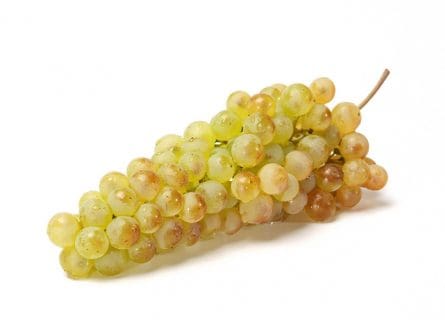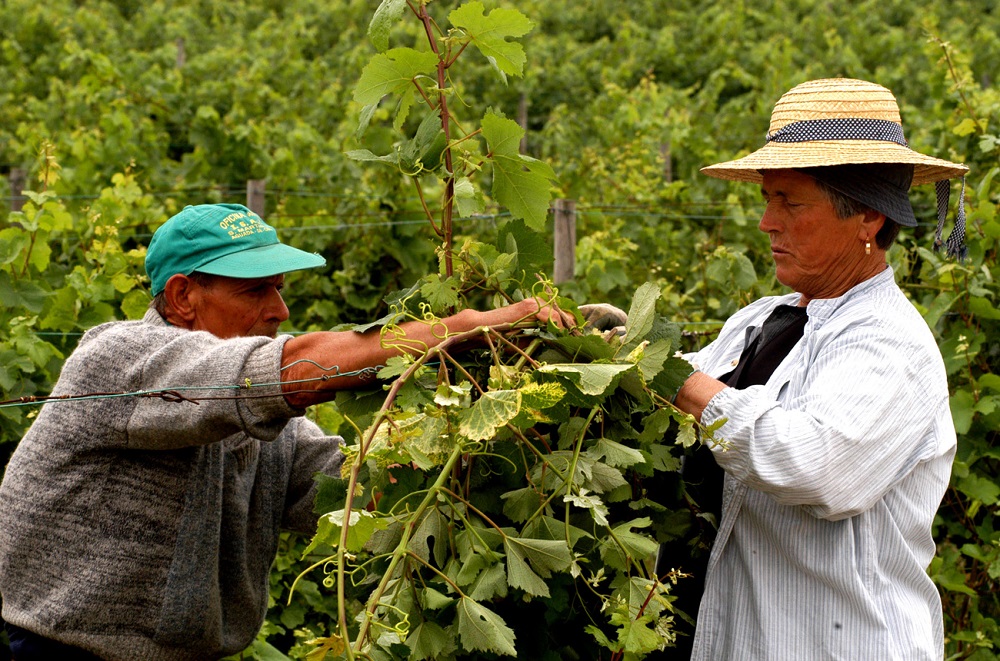
Chasselas Grape Variety: A Swiss Prodigy
August 22, 2022
Chasselas is a white wine grape varietal grown mainly in Switzerland but has a strong historical link with France's Loire and Savoire regions.
By: James lawrence / Last updated: February 3, 2025
Estimated reading time: 8 minutes
In the 20th century, making a case for obscure grape varieties like Bical took a lot of work. As global demand coalesced around familiar wine styles (Kiwi Sauvignon Blanc remains a household name), there was little appetite for the weird and wonderful. And so it must have been sorely tempting for Portuguese growers to rip out every last plot of Bical and replace it with Pinot Grigio.

Guide to Portuguese White Wine: Read more
But they didn’t. As fortune would have it, this has become a major advantage when competing for restaurant listings and retail space. Indigenous varieties are achingly trendy in 2023 – so too are aromatic white wines that offer a point of difference at an affordable price point. So if you’re reticent about giving Portuguese whites a chance, we implore you to sample a glass of Bical. This a grape that can change even the most intransigent of minds!
Bical has long been associated with the hilly terrain of Bairrada – one of Portugal’s up-and-coming wine regions. Yet viticulture did not become established in this part of central Portugal until the 10th century. Perhaps the Roman conquerors, who subjugated the Iberian Peninsula in the 3rd century BC, did not regard the inclement climate of Bairrada as prime wine country. Nevertheless, the Romans encouraged viticulture in many parts of Spain and Portugal, while their infrastructure projects and advanced political culture transformed the social fabric of Western Europe.
Finally, however, the empire began to weaken in the 3rd century, paving the way for its eventual collapse and ruin in 476 AD. Sensing a golden opportunity, barbarian tribes from northern Europe attempted to conquer the peninsula in the aftermath of the Western Empire’s disintegration. They got as far as Toledo, where the Visigothic king Roderic saw his momentary rule end in 711. That year, an invasion force led by the Moorish leader Tariq arrived on Spanish soil. Within several years, the Moors controlled large swathes of Spain and Portugal, endowing cities such as Granada and Cordoba with a long-lasting cultural legacy.
However, the reconquest of these Moorish-held territories soon began to dislodge their grip over Spain and Portugal. Indeed, vines were planted in the Bairrada region after the Moors were ejected from central Portugal in the 10th century. Unlike the Romans before them, the peninsula’s Christian monarchs were keen to see viticulture expanded to every corner of their recaptured lands. In the 12th century, Alfonso Henriques recognized Portugal as an independent kingdom; this signified the beginning of the nation’s transformation into a major European power. Great explorers, the most famous being Vasco de Gama, founded colonies in central Asia and South America.
Meanwhile, the vineyards of the Douro River became associated with strong red wines in the 1600s, fortified and protected with the addition of grape spirit. Yet, cross-regional blending was very common during this era: Port producers would ‘adulterate’ their wines with the tannic Baga grape (a specialty of Bairrada), adding heft and alcohol to the final product.
Unfortunately, Portugal’s run of prosperity was about to end. Although the country recovered from the Spanish occupation after they were driven out in 1640, the loss of Brazil hurt the nation’s finances. Bairrada’s winegrowers were also punished for mislabeling their wines as Port; the government ordered that every vine in the district be uprooted! So, too, did Napoleon’s invasion reduce Portugal’s wine industry to a shadow of its former self – a country without power and influence. By the late 1800s, widespread poverty was the defining feature of life in many of Portugal’s communities. Yet there were also some positive developments: Bairrada had started to cement a reputation within Portugal as a source of high-quality wines.
Moreover, an agronomist named António Augusto de Aguiar helped define the region’s boundaries in the 1860s, subsequently founding a wine school to encourage best practices throughout the zone. This resulted in the production of Bairrada’s inaugural sparkling wine, released in 1890 to great acclaim. Over time, a niche endeavor morphed into a thriving business—over 50 percent of all Portuguese sparkling wine is now made in the Bairrada region.
Could all this have been achieved without Bical? It seems unlikely: sparkling wine requires high-acid grapes responsible for the endless refreshment that all good bubbly provides. Indeed, a sparkling wine that does not refresh the palate is no sparkling wine at all. This is where Bical comes in. Colorfully referred to as Borrado das Moscas (“fly droppings’) by local growers, Bical has much in common with Arinto. Like that splendid grape, Bical can tolerate heat and drought, maintaining good acidity levels even in warm Mediterranean climates.
However, Bical is an early ripening variety; if the berries are left too long on the vine, their acidity can drop quickly in particularly hot years. Bical is also very susceptible to powdery mildew, although rot is seldom an issue. The most significant danger for winegrowers is an excess of alcohol and a lack of structure, two problems that can be avoided by picking at the right moment.
Traditional-method sparkling wine has been a Bairrada specialty since the late 1800s. Produced with skill and panache, it inevitably places Bical at the heart of the blend. It is often joined by red grape Baga, Arinto, and occasionally the noble white grape of the Cote de Blancs: Chardonnay.
Yet don’t come to Bairrada expecting to taste a Portuguese facsimile of Champagne. It is a world apart – sparkling Bairrada’s tropical fruit profile would not be readily associated with France’s leading bubbly. However, the production methods are broadly similar. Under EU law, all traditional-method wines must undergo a secondary fermentation in bottle.
To summarize, grapes are gently pressed before the free-run juice is settled into a tank. It is then fermented – typically in concrete or stainless steel tanks. These base wines are subsequently blended and bottled with the addition of a sugar-yeast concoction. Then the magic happens: the yeast starts to devour the sugar, releasing carbon dioxide as a by-product of the process. Voila – a wine that sparkles! Depending on the priorities of the grower, the wine will then be aged on its fine lees (dead yeast cells) for between 12 months to several years. After that time, the yeasty sediment will be ejected via a process called disgorgement. It is then brought to market.
Of course, Bical is also used to make some pretty nifty still wines. Many are produced in a way that echoes the initial stages of sparkling wine production:
You’ll encounter this paradigm the world over, from the vineyards of Casablanca in Chile to the Riesling villages of the Mosel. As a rule, it provides a cast-iron guarantee of producing a very consumer-friendly style of white: fresh and fruit-driven. But deviations are by no means unheard of; a touch of skin contact here, a period of oak aging there, and something entirely different emerges. So yes, it is possible to coax more tropical and textured elements out of Bical if the winemaker desires. Yet, from our perspective, Bical is at its best when the fruit and freshness are brought to the fore.
Bairrada was once viewed as Portugal’s ‘poor relation’ – a source of agreeable rustic wines when all other options had been exhausted. However, this is old news. White Bairrada is on a roll: modern expressions, with their innate freshness and poise, are making waves with sommeliers and key influencers worldwide. Indeed, a mineral ‘hit’ and acidity cut to local wines elevates them to the top ranks of summer refreshment.

It is also a very attractive place to visit. Few tourists have discovered this enclave in northern Portugal – so much the better for discerning travelers! Situated close to the Atlantic, Bairrada is the ideal destination to fashion high-acid whites due to the cooling breezes and temperate climate. Historically, the pale-skinned Bical was planted on unsuitable terrain: sandy soils that yielded flabby and uninspiring wines. However, today’s growers are making the most of the region’s calcareous soils, exploiting the best sites to fashion excellent still and sparkling wines. Awarded DOC status in 1980, Bairrada has transformed into a 21st-century success story. It is one of Europe’s most exciting sources of esoteric flavors, with very little land given over to international grapes.
Interestingly, when sommeliers and critics discuss Bical whites, they often compare them to Riesling. There is some truth to this: like Riesling, Bical evolves into honeyed complexity after several years bottle age, offering tertiary aromas of buttered toast, lanolin, and kerosene. Yet these excitingly long-lived wines – blends and mono-varietal – show great diversity. Some bottles we encountered were reminiscent of tart Muscadet, with a certain austerity and minerality that also recalled cool-vintage Chablis. Others, however, are concentrated and voluptuous, an excess of ripe fruit that can handle the richest sauce imaginable. Add some exceptional – and distinctive – sparkling wine into the mix, and you have a recipe for global conquest. It’s still early days, but the word is spreading. Bairrada is on the up.
If you would like us to customize an exclusive luxury tour, contact us and let us know your travel plans. We offer luxury food and wine tours for private groups of a mininium two guests. In addition, all of our private, chauffeured tours are available year-round upon request.

